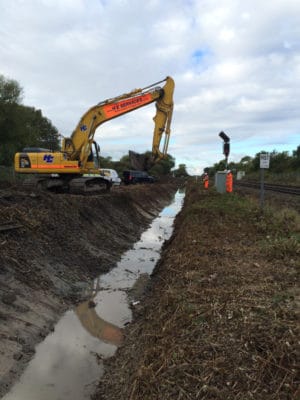Project: Priority drainage programme
Customer: Network Rail
Sector: Rail
Location: South West England
The challenge
UKDN Waterflow (LG) was commissioned to carry out a number of high priority projects under the Drainage Accelerated Maintenance Project. This was a programme to rapidly improve drainage on areas of line where drainage conditions impacted greatest on customer service, for example the need to impose track speed restrictions.
The solution
We worked with Network Rail’s track maintenance engineering team and small project team to review the existing drainage work bank for the Western Route. This identified the highest priority projects. UKDN Waterflow (LG) then put together a multi-disciplinary team to carry out the range of work required, including drainage ditch rework, root cutting, excavation and the repair and replacement of track drainage systems.
Customer comment
“UKDN Waterflow (LG) resolved a number of critical drainage issues through DAMP. It has also helped to raise the profile of drainage across the Western Route. This demonstrates the effectiveness of parties working together with limited funding, to over-deliver and demonstrate value in an area which is now a vital part of physical works.”
Patrick Hallgate, Route Managing Director
Implementation
We carried our drainage improvement work at 19 sites. This included the completion of drainage works at two critical track speed restriction sites. At each site, the aim was to greatly improve or solve specific long-standing drainage issues. The success of the project was measured using a number of indicators, including the future level of manual intervention works required, track quality banding and/or the removal of the relevant track speed restriction.
Case studies
Edington Station – rail catchpit rebuild and pipe relay
Over three Saturday nights, two catchpits were rebuilt. More than 30m of pipe was relayed, a process that required the removal of 25 tonnes of rubble. Also, 15m of ditching was rehabilitated.
Blatchbridge Junction, Frome – rail catchpit and ditch cleaning
Over four Saturday nights, 47 catchpits were cleaned and 10 new glass-reinforced plastic (GRP) lids fitted. Work also included relaying 40m of 600mm diameter pipe. Rail weighing over 10 tonnes was removed, along with 10 concrete and five wooden sleepers. 50m of ditching was cleared, and vegetation work completed.
Results
Track drainage at high priority sites along the Western Route was greatly improved. Track speed restrictions could be lifted at both the TSR sites we worked at. The project proved the benefit and viability of increasing planned drainage maintenance work, resulting in greater resource being put into this area work.


